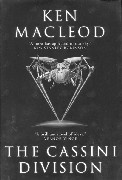 The
Cassini Division
The
Cassini Division
by Ken MacLeod
A book review by Mark L. Olson
Tor, 1999, 240 pp, $22.95
The Cassini Division (pun intended) is the elite military force of the Solar Union which guards the Union against the post-Humans who put an interstellar wormhole into orbit around Jupiter, but retreated to its surface when their merely human slaves escaped through the wormhole. The post-Humans have since been flooding the Solar System with computer viruses, but otherwise haven't ventured off the planet. So far this sounds like old-fashioned space opera.
But the Solar Union is a communist utopia where nano technology has guaranteed effectively unlimited material wealth for everyone, yielding a non-money economy, and which is loosely governed -- including the Cassini Division itself -- by open, elected committees.
The story is cleverly designed to provide a tour of the Solar Union, beginning on Earth as the main character -- a very influential ship captain in the Division -- searches for a physicist who may be able to understand the wormhole and who disappeared years previously into an enclave of non-cooperators (people who deliberately turn their backs on the communistic Solar Union and retain a primitive money-based economy in their enclaves around London.)
The adventure next carries them to Cassini Division HQ on Callisto, then through the wormhole to New Mars, a capitalist society built by the escaped slaves, where they are able to successfully destroy the post-Humans once and for all. (New Mars is the setting for another of MacLeod's novels, The Stone Canal.)
Many SF novels get their kick from speculative science. The Cassini Division indulges in speculative social organization. The utopian Solar Union is plausible enough in many respects -- it's hard to see how a money-based economy could survive in the face of cornucopian nanotechnology, and it's easy to imagine local society being looking a lot like the Solar Union's. But MacLeod's nano is capable of being easily turned to destruction -- the gray goo problem -- and I doubt that any society could survive without much more defense against that than the Solar Union's. (The main character mutters about orbital zaps being used to deal with outbreaks. Nonsense! No one would be willing to allow whole cities to be obliterated to deal with nano outbreaks which could be handled less spectacularly by a police force. The first time a city is wiped out, people everywhere would demand policing of nano and a pervasive governmental presence would be inevitable.)
Ignoring that, the other big oddity is the very peculiar theoretical underpinnings of the Solar Union's economic and political philosophy. Instead of being based on universal altruistic cooperation -- the New Communist Man idea -- it seems to be based on a Randian notion of selfishness as the only virtue. Evidently enlightened self interest yields a communist utopia.
It's implausible when the Libertarians preach it, and I don't believe it here, either. I'm afraid that this is the political equivalent of the long, gobbledegook science explanation so beloved of the super science stories where three pages of physics fast-talk ends with a combination FTL drive and super-zapper. It was entertaining to see someone ringing the changes like that, though.
(I wish I know more about Trotskyite beliefs. I have the sense that MacLeod may be making some amusing Trotskyite jokes.)
The Cassini Division is an excellent piece of SF, treating us to good adventure, an interesting future and some neat social and political variations. It is also related in a complex way to another MacLeod novel, The Sky Road.
See also my reviews of other Ken MacLeod books: Engine City, Cosmonaut Keep, The Cassini Division,. The Sky Road, The Stone Canal, Dark Light, The Human Front
NESFA homepage | Review Index | More Reviews by Mark L. Olson
